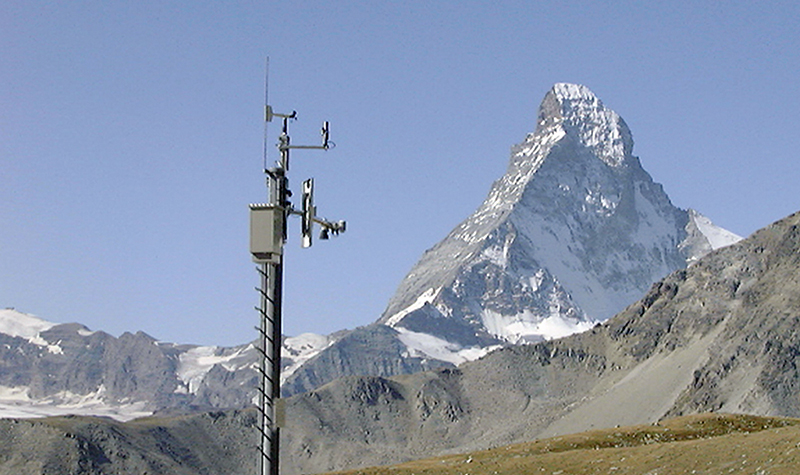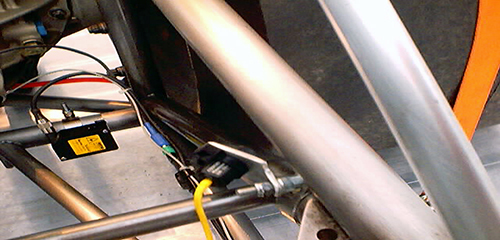
Going Places No Infrared Temperature Devices Have Gone Before
A leading manufacturer of noninvasive, infrared temperature sensors, Exergen Corporation prides itself on delivering a highly accurate and reliable product to exceed customers' expectations. The Watertown, Massachusetts-based company's forte is designing custom infrared thermocouples (IRt/c™s) for professional and consumer use in a wide variety of industrial and medical applications. In 2002, NASA's Glenn Research Center approached Exergen with a simple request to modify the company's product line, reducing the size of its sensors. The outcome led to the development of a family of top-notch IRt/c devices that are pushing production line performance to record highs.
Glenn was seeking an infrared temperature sensor with an extremely small head for a joint flywheel research project with the University of Texas' Center for Electromechanics. Already having created the smallest infrared temperature device available in one package (.5 inches in diameter and 1.45 inches in length), Exergen was up for the challenge. The company claimed that making a shorter unit was easy; however, this was not the area Glenn was hoping to address. Engineers at the NASA research center required a smaller diameter of a quarter-inch for their project, half the size of Exergen's existing device. With funding and support from Glenn, Exergen prevailed in meeting the NASA specifications, and the patented IRt/c™ technology was born.
Exergen's IRt/c is a self-powered sensor that matches a thermocouple within specified temperature ranges and provides a predictable and repeatable signal outside of this specified range. Possessing an extremely fast time constant, the infrared technology allows users to measure product temperature without touching the product. The IRt/c uses a device called a thermopile to measure temperature and generate current. Traditionally, these devices are not available in a size that would be compatible with the Exergen IRt/c, based on NASA's quarter-inch specifications. After going through five circuit designs to find a thermopile that would suit the IRt/c design and match the signal needed for output, Exergen maintains that it developed a model that totaled just 20 percent of the volume of the previous smallest detector in the world.
Following completion of the project with Glenn, Exergen continued development of the IRt/c for other customers, spinning off a new product line called the micro IRt/c. This latest development has broadened applications for industries that previously could not use infrared thermometers due to size constraints. The first commercial use of the micro IRt/c involved an original equipment manufacturer that makes laminating machinery consisting of heated rollers in very tight spots. Accurate temperature measurement for this application requires close proximity to the heated rollers. With the micro IRt/c's 50-millisecond time constant, the manufacturer is able to gain closer access to the intended temperature targets for exact readings, thereby increasing productivity and staying ahead of competition.
All Exergen IRt/c sensors come hermetically sealed in a range of sizes and configurations, depending upon the application. They are designed for years of trouble-free operation in the toughest environments. In fact, IRt/c sensors are so rugged, professional auto racing teams use them to measure critical temperature variables during competition. Such critical variables include tire temperature, which directly affects tire adhesion and wear characteristics, and provides valuable data on the set-up and performance of the suspension. For example, excessive loading of a tire caused by out-of-tune suspension will cause it to become considerably warmer than the vehicle's other tires. Exergen IRt/c's were displayed in action at the 2002 Race-A-Rama show in Springfield, Massachusetts. Dittman & Greer, Inc., an Exergen distributor from Middletown, Connecticut, used the technology to measure torque converter, tire, and track temperature throughout the event.
In a separate application, the infrared temperature sensor is being utilized for avalanche warnings in Switzerland. The IRt/c is mounted about 5 meters above the ground to measure the snow cover throughout the mountainous regions of the country. The sensor is part of a larger "snow-station" that records ambient temperature, solar radiation, snow height, snow drift, wind flow, wetness, and ground and air motion.
With IRt/c, Exergen offers system solutions and technical application support for any thermal process requiring precise temperature measurement or control. More than 300 models of noncontact infrared sensors are available to provide accurate, reliable, and cost-effective temperature measurements and control for the most demanding applications.
IRt/c™ is a trademark of Exergen Corporation.

Exergen Corporation’s noncontact IRt/c™ sensor (middle) measures tire temperature for the Ola Nordell Racing Team’s top dragster. An accompanying laser is used to measure ride height and traction.

The IRt/c™ technology is mounted on a remote station monitoring snow cover on the famous Matterhorn in the Swiss Alps.













